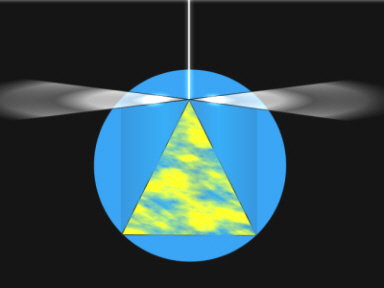
Two Clouds Of Eyewitnesses -
On the previous page is a more recent image of the same site, albeit more eroded. The FIMIOL below reflects the Place of the Skull, three crosses and two tablets on which were written the Ten Commandments.
© 2019 Wayne J Zanker [FIMIOL Photographics]
If Acaph's sanctuary is considered the first, then pursuing a third temple is a waste of time and energy, since that was destroyed on Ab 10 in 70 CE. Why not build the fourth at Chebrown (Hebron) or Beyt-
Referring to "all meeting places" or "congregations" (kol mowadhey-
This one, already in existence during the reign of Melkitsedeq, had to go in order to make way for the new sanctuary where the sons of Ya'aqob could serve Yahuw'ah. Typically El Elyown submitted to Him.
Shelomoh, not Daviyd, built that temple on the threshing floor of Ara'uwnah the Yebusite. Daviyd only erected an altar there (2 Samuel 24:18-
As for Paul's THEOS being "the judge of all" (12:23) and his Jesus being a mediator between THEOS and men (1 Timothy 2:5), both are patently false.
Throughout Matthew's gospel Yeshuwa is the king and judge of all the Earth, not THEOS/God (Matthew 25:31-
As the judge He cannot be one who approaches the bench or throne and pleads any man's cause.
How much Nirvanic thinking is in the Book of Hebrew's heaven is a matter of speculation. The apostle Paul had adapted first-
While so many elements of it are found in his writings, others are not, like reincarnation. His version put an end to that with his preoccupation with faith, hope and love. Hebrews 9:27 supports him. He also retained the Greek Bible's THEOS, not found in Buddhism.
Observe how Hebrews 12:22-
"22. But you have approached Mount Zion and to a city of a living THEOS, to a heavenly Yeruwshalem, and to myriads of angels,
23. to an assembly and church of firstborn ones enrolled in (the) heavens and to THEOS judge of everyone, and to spirits of just ones made perfect,
23. and to Jesus, mediator of a new testament/covenant, and to sprinkled blood speaking better things than Abel."
 This so lacks detail. It is just a cluster of ideas. Nor is there any mention of the twenty-
This so lacks detail. It is just a cluster of ideas. Nor is there any mention of the twenty-
Foundations, the four walls and gates and the enormous pyramid in the background are missing too. The Temple of Eluhiym sits at the apex.
Here Theodorus, like the physician Luke, chose to express himself differently to Paul, while still retaining many of the Christian basics.
Already during the early sixties CE their movement was starting to show cracks, brought about by singular research or else the lack of it. Paul's allegorical interpretation of his 'old testament' did not help.
From his conspicuous silence on the matter one would have to conclude that the author of Hebrews also rejected the teaching of the new Earth under a different sky. He had another Heaven in mind, a sort of Nirvana.
In addition, he knew nothing of the other Eluhiym who lived on Earth and wrote portions of the Hebrew scriptures. Nor was he aware that all twenty-
